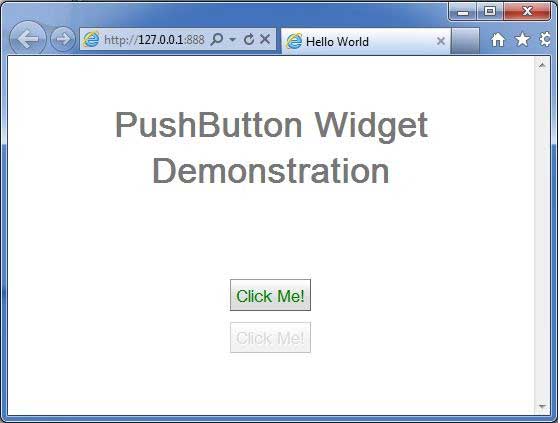
- GWT Tutorial
- GWT - Home
- GWT - Overview
- GWT - Environment Setup
- GWT - Applications
- GWT - Create Application
- GWT - Deploy Application
- GWT - Style with CSS
- GWT - Basic Widgets
- GWT - Form Widgets
- GWT - Complex widgets
- GWT - Layout Panels
- GWT - Event Handling
- GWT - Custom Widgets
- GWT - UIBinder
- GWT - RPC Communication
- GWT - JUnit Integration
- GWT - Debugging Application
- GWT - Internationalization
- GWT - History Class
- GWT - Bookmark Support
- GWT - Logging Framework
- GWT Useful Resources
- GWT - Questions and Answers
- GWT - Quick Guide
- GWT - Useful Resources
- GWT - Discussion
GWT - PushButton Widget
Introduction
The PushButton widget represents a standard push button with custom styling.
Class Declaration
Following is the declaration for com.google.gwt.user.client.ui.PushButton class −
public class PushButton extends CustomButton
CSS Style Rules
Following default CSS Style rules will be applied to all the PushButton widget. You can override it as per your requirements.
.gwt-PushButton-up {}
.gwt-PushButton-down {}
.gwt-PushButton-up-hovering {}
.gwt-PushButton-down-hovering {}
.gwt-PushButton-up-disabled {}
.gwt-PushButton-down-disabled {}
Class Constructors
| Sr.No. | Constructor & Description |
|---|---|
| 1 |
PushButton() Constructor for PushButton. |
| 2 |
PushButton(Image upImage) Creates a PushButton with up state image. |
| 3 |
PushButton(Image upImage, ClickListener listener) Creates a PushButton with up state image and clickListener. |
| 4 |
PushButton(Image upImage, Image downImage) Creates a PushButton with up state image. |
| 5 |
PushButton(Image upImage, Image downImage, ClickListener listener) Creates a PushButton with up state image. |
| 6 |
PushButton(java.lang.String upText) Creates a PushButton with up state text. |
| 7 |
PushButton(java.lang.String upText, ClickListener listener) Creates a PushButton with up state text and clicklistener. |
| 8 |
PushButton(java.lang.String upText, java.lang.String downText) Creates a PushButton with up state and down state text. |
| 9 |
PushButton(java.lang.String upText, java.lang.String downText, ClickListener listener) Creates a PushButton with up state, down state text and click listener. |
Class Methods
| Sr.No. | Function name & Description |
|---|---|
| 1 |
protected void onClick() Called when the user finishes clicking on this button. |
| 2 |
protected void onClickCancel() Called when the user aborts a click in progress; for example, by dragging the mouse outside of the button before releasing the mouse button. |
| 3 |
protected void onClickStart() Called when the user begins to click on this button. |
Methods Inherited
This class inherits methods from the following classes −
com.google.gwt.user.client.ui.UIObject
com.google.gwt.user.client.ui.Widget
com.google.gwt.user.client.ui.FocusWidget
com.google.gwt.user.client.ui.CustomWidget
java.lang.Object
PushButton Widget Example
This example will take you through simple steps to show usage of a PushButton Widget in GWT. Follow the following steps to update the GWT application we created in GWT - Create Application chapter −
| Step | Description |
|---|---|
| 1 | Create a project with a name HelloWorld under a package com.tutorialspoint as explained in the GWT - Create Application chapter. |
| 2 | Modify HelloWorld.gwt.xml, HelloWorld.css, HelloWorld.html and HelloWorld.java as explained below. Keep rest of the files unchanged. |
| 3 | Compile and run the application to verify the result of the implemented logic. |
Following is the content of the modified module descriptor src/com.tutorialspoint/HelloWorld.gwt.xml.
<?xml version = "1.0" encoding = "UTF-8"?> <module rename-to = 'helloworld'> <!-- Inherit the core Web Toolkit stuff. --> <inherits name = 'com.google.gwt.user.User'/> <!-- Inherit the default GWT style sheet. --> <inherits name = 'com.google.gwt.user.theme.clean.Clean'/> <!-- Specify the app entry point class. --> <entry-point class = 'com.tutorialspoint.client.HelloWorld'/> <!-- Specify the paths for translatable code --> <source path = 'client'/> <source path = 'shared'/> </module>
Following is the content of the modified Style Sheet file war/HelloWorld.css.
body {
text-align: center;
font-family: verdana, sans-serif;
}
h1 {
font-size: 2em;
font-weight: bold;
color: #777777;
margin: 40px 0px 70px;
text-align: center;
}
.gwt-PushButton {
color:red;
}
.gwt-PushButton-up {
color:green;
}
.gwt-PushButton-down {
color:blue;
}
.gwt-PushButton-up-hovering {
color:pink;
}
.gwt-PushButton-down-hovering {
color:aqua;
}
.gwt-PushButton-up-disabled {
color:lime;
}
.gwt-PushButton-down-disabled {
color:maroon;
}
Following is the content of the modified HTML host file war/HelloWorld.html.
<html>
<head>
<title>Hello World</title>
<link rel = "stylesheet" href = "HelloWorld.css"/>
<script language = "javascript" src = "helloworld/helloworld.nocache.js">
</script>
</head>
<body>
<h1>PushButton Widget Demonstration</h1>
<div id = "gwtContainer"></div>
</body>
</html>
Let us have following content of Java file src/com.tutorialspoint/HelloWorld.java which will demonstrate use of PushButton widget.
package com.tutorialspoint.client;
import com.google.gwt.core.client.EntryPoint;
import com.google.gwt.event.dom.client.ClickEvent;
import com.google.gwt.event.dom.client.ClickHandler;
import com.google.gwt.user.client.Window;
import com.google.gwt.user.client.ui.PushButton;
import com.google.gwt.user.client.ui.RootPanel;
import com.google.gwt.user.client.ui.VerticalPanel;
public class HelloWorld implements EntryPoint {
public void onModuleLoad() {
//create a push button
PushButton pushButton = new PushButton("Click Me!");
//create a push button
PushButton pushButton1 = new PushButton("Click Me!");
//disable a push button
pushButton1.setEnabled(false);
//add a clickListener to the push button
pushButton.addClickHandler(new ClickHandler() {
@Override
public void onClick(ClickEvent event) {
Window.alert("Hello World!");
}
});
// Add push buttons to the root panel.
VerticalPanel panel = new VerticalPanel();
panel.setSpacing(10);
panel.add(pushButton);
panel.add(pushButton1);
RootPanel.get("gwtContainer").add(panel);
}
}
Once you are ready with all the changes done, let us compile and run the application in development mode as we did in GWT - Create Application chapter. If everything is fine with your application, this will produce following result −

When you click Click Me button, it will show an alert message Hello World!
You can see color of button text and its state will change with your interaction.
Hover over the button, color will be pink.
Press the button, color will be aqua.
Release the button, color will be green.